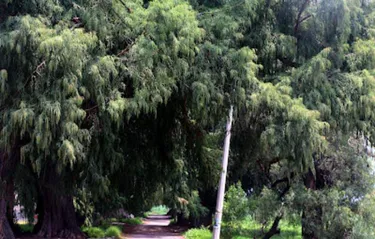The last vestige of the gardens of the poet king Nezahualcóyotl is located in the ejido San Felipe, in Texcoco, State of Mexico, where a grove of 72 ahuehuetes up to 40 meters high rises to the pride of the ejidatarios, who have been propagating the seed for 25 years, and now offer one of their specimens to Mexico City, to transplant it to the Glorieta de Reforma.
“These Ahuehuetes are 700 years old; history says that Nezahualcóyotl, the king of Texcoco, the poet king, planted them,” said Mario Meza, representative of the San Felipe and Santa Cruz de Texcoco Ejido, in an interview. The grove of 72 centennial ahuehuetes reach 40 meters in height with diameters of six to eight meters; their presence is an oasis in the municipality; Texcocanos stroll under their powerful shade and organize picnics on the weekends.
In addition to the centennial ahuehuetes, the locals have planted another 160 ahuehuetes up to 25 years old, to preserve the botanical heritage of the poet king.
“In all the kingdom of Nezahualcóyotl there were always groves of trees, wherever he put his hand, he planted Ahuehuetes, which is the national tree of Mexico. Ahuehuete means Old man of the water,” said Mario Meza.
The grove is located in the Texcoco ejido of San Felipe, about four kilometers from the Municipal Palace of Texcoco, and about 35 kilometers from the traffic circle, where two specimens brought from Montemorelos, Nuevo León, have had difficulty adapting to the conditions of the capital. For this reason, the representatives of the ejido, offer two of their specimens to be transplanted to the famous roundabout.

“Here is this little tree, if you like, we can donate it to Mexico City, since its habitat is very close,” said Sixto Onofre, representative of Ejidos San Felipe and Santa Cruz.
In a tour, the ejidatario Mario Meza showed in his plot, one of the young trees that he says, is ready to be transplanted to Paseo de la Reforma.
“If they want it, this Ahuehuete is available, it is 25 years old and we would gladly donate it to the government of Mexico City. This tree would be more adaptable to the local climate, it would withstand even air pollution,” he said.
He added that this year, as part of the productive programs promoted by the National Commission of Natural Protected Areas (CONANP) for Lake Texcoco, members of the ejido were able to obtain subsidies to establish a nursery for the production of 3 to 5 thousand ahuehuetes, ashes, and ahuejotes each year.

More than a hundred days after the arrival of the second Ahuehuete to the roundabout on Paseo de la Reforma, it looks dry and decayed; the specialist of the Universidad Autónoma Metropolitana (UAM), Saúl Alcántara, has maintained that the tree is hopeless; while the member of the committee of experts for the care of the Ahuehuete, Édgar Ojeda, assures that the tree is still alive, and adapting slowly.
“This shock implies that the tree loses its leaves or goes through this process of autumnization, as it is known when it changes color, leaves change from green color to golden or brown color, and then the tree begins to work within itself to develop the energy to create these new shoots,” was Ojeda’s explanation.
TYT Newsroom


